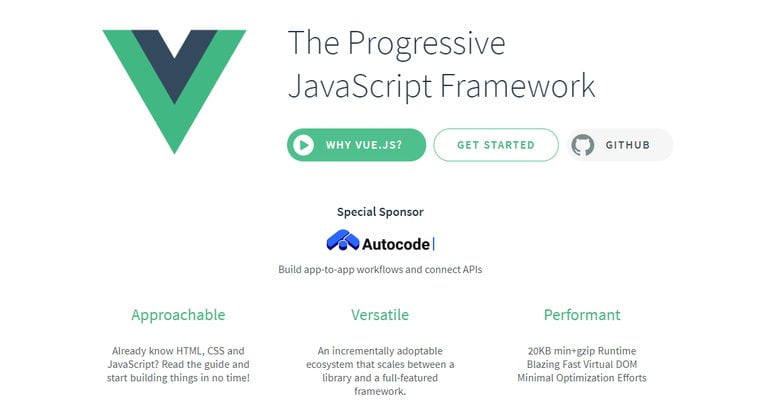If we’d to take a glimpse at the world of web development, the outsiders would say that programmers have it good – the vast amount of software available at their fingertips makes development accessible, easy and smooth.But is it really so?
While it’s true that developers have an abundance of software at their disposal, not of them are created equal. As such, it can be confusing for newcomers to choose their ideal first platform, though seasoned developers can also get overwhelmed if they’d like to get familiar with a new piece of software.”Will it fit my current needs?”, “Will it save me time?”, “Will it give me the tools I need to be more efficient and to create modern apps?”
If these are the questions on your mind regarding Vue.js, here are 7 great advantages that might make you consider using this handy framework.
Enter Vue.js
When we say that JavaScript has become a fully-fledged ecosystem instead of just a language, we’re not exaggerating and tools like frameworks are a fine example of that. They are like phrasebooks to the language, making the development cycle smoother, more streamlined, and ultimately, a lot more simple.
JS has a large framework market and trends come and go. There are loads of great software out there that allow developers to create gorgeous and functional websites. React and Angular are the two leaders of the market, however, there’s also another rising contender that’s worth developers’ attention. That’s right, we’re talking about Vue.js.
The software became immensely popular in the past few years and is still gaining ground and coveted supporters.
In this article, we are going to take a better look at this contender, talk about its ecosystem, advantages and possible drawbacks, so you can gain more knowledge about how it works and decide if the qualities it has to offer suit your current needs.
What is Vue.js?
The initial concept of the framework was forged back in 2013 by Evan You, working at Google at the time, combining different handy features of different frameworks, creating different prototypes. A year later, Vue.js has seen its official release.
Technically speaking, Vue.js is a JavaScript-based progressive framework used for one-page apps and web interfaces but can also be used for mobile and desktop app development in conjunction with the Electron framework.
With HTML extension and the JavaScript base, Vue has quickly become a popular tool for the front-end, being adopted by names such as Gitlab, Xiaomi, Alibaba, Adobe, and Behance.

According to its creator, the framework’s initial purpose was to become a lighter, and improved version of Angular.
The framework corresponds to the classic MVC (Model-View-Controller) architecture, with the core library of Vue.js focusing on the view out of the box, but it doesn’t mean that it can’t be used with different architectures in mind, with the right tweaking and software.
The Vue.js Advantages
What made Vue:js such a popular framework in the developer community? What does it have to offer in comparison to the other heavy-hitters in its league? Let’s see what makes Vue.js such an outstanding framework.
1. Lightweight
No fuss, just what you really need in a lightweight package, only a few kilobytes in zip format. With such featherweight characteristics, Vue is lightning-fast to download and install. As such, it also has a positive impact on UX and SEO.
2. Virtual DOM performance and rendering
When rendering web pages, chances are pretty good that you’ll run into a DOM or a Document Object Model. This model represents the HTML pages with all styles, page content, and elements as objects which are stored as a tree structure and during page loading, they are generated by the browser.
When instances of user interaction happen with the page, the objects change their own state and the browser has to update the info changes and also, render it on the display. The only problem with this is that updating the entire DOM can be a cumbersome process.
So to improve the process, Vue.js uses a virtual DOM, a copy of the website’s original DOM, that the framework uses for figuring out element updates without having to render the entire DOM, thus improving app performance and making page rendering rather quick.
Better performance and overall speed is a crucial key point for most developers when it comes to choosing the ideal framework. In this respect, Vue.js has managed to climb among the best, giving both Angular, React, and Vanilla.js a run for their money. It is a serious contender and new versions, updates, and improvements can predict an even better trajectory.
However, keep it in mind that in real-life situations, the core of the performance is based on code optimization and overall quality.
3. Two-way data binding
Vue stores another DOM-manipulation benefit, that is known as two-way data binding. Vue inherited this feature from Angular. It basically describes the connection between model data updates and the view (UI), with bound components containing data that you can update from time to time.
With two-way data binding, updating related components and tracking data updates in general, becomes easier.
Bound data receives reactive updates in Vue just like DOM objects. This feature makes the framework ideal for applications with real-time updates. Regarding development, this reactive nature can make updating data more streamlined and easier.
4. Easy to get started
Truth be told, complex and hard to learn tools rarely get immensely popular. Vue doesn’t require programmers to have years and years of prior experience in coding, in-depth library knowledge, TypeScript, and JSX, as it is with the majority of other front-end frameworks and technologies.
According to the professionals, Vue only requires developers to know the basics of HTML, JavaScript, and CSS to get started and take it from there.
As a bonus, Atom, Sublime Text and Visual Studio (some of the most popular code editors) all support Vue, which means that giving the framework a try can be even easier. On the other hand, there’s a huge community out there for greenhorns gladly answering all their questions on Discord forums and chats. Not to mention the vast number of different courses and guides on the world wide web.
Being easy to master is always a good selling point for a framework, especially today, where time is of the essence in web development. A fairly simple piece of software can help a great deal even experienced developers to jump into different projects with different architectures and criteria.
Also, a simple framework gives programmers the opportunity to broaden their horizons and learn to use more tools. Flexibility is an excellent quality in every profession and developers can gain a great deal from it too.
5. Readability and single-file components
Vue uses components to build your web page, meaning that every piece of your application is a different component that represents an encapsulated element of the interface itself. These components can be written in JavaScript, CSS, and HTML without the need to divide them into separate files.
Application code-splitting is an approach utilized in CBA, or Component-Based Architecture, and are key features in such contenders as React or Angular.
An architecture with traits like this also means a couple of benefits:
- Reusable Components – the encapsulated components can be referred to as code chunks that developers can reuse as templates for similar elements.
- Great Unit-testing – the testing process is configured as a QA-activity that checks how the smallest parts perform in the app on their own. The component-based approach greatly simplifies this process.
- Code Reading – Every component is stored in separate files (with each component being a single file), making code readability a lot easier. This feature makes the application easier to maintain and can take a lot of guesswork out of troubleshooting.
6. Flexibility, integration capabilities, and tooling ecosystem
Being able to integrate new tech with existing apps is a crucial feature for every software and Vue.js makes this process a breeze because it only needs JavaScript to work and needs no other tools.
In Vue, you can write templates using JS, HTML, or a JavaScript syntax extension called JSX. On the other hand, if developers decide to make a shift from Angular or React to Vue, the transition won’t be a problem since it’s basically a mixture of the two making for a familiar platform out of the box.
Apart from great integration and flexibility, Vue also boasts a great ecosystem with a powerful set of handy tools that can make development streamlined, quick, and a great experience.
7. Great documentation and community support
Having comprehensive documentation at your fingertips that’s easy to understand is a huge part of every framework’s success. Documentation will always be valued by experienced and greenhorn developers alike and Vue’s documentation will most probably provide an answer to every question or issue.
The documentation is structured well, and covers a vast number of topics, guiding through the user everything from installation to more complex processes like app scaling and reactivity. The documentation even features sections where it compares Vue to other JS frameworks pointing out differences and things in common. This feature can come insanely handy for developers with prior experience with JavaScript frameworks who need or wish to transit to Vue.
On the other hand, Vue has great community support with active community members who are always ready to help everyone who’s facing issues during the development process.
Great community support and documentation are also important features of every successful framework. Newcomers can even shorten the learning curve with documentation and active participation in online discussions. Having such help at their disposal can encourage them to learn and master the framework.
To Sum It All Up
All in all, Vue.js boasts a number of awesome features making it ideal for everybody who wants to get started with JS frameworks and is also ideal for those who want to make a transition from React or Angular.
The framework itself was based on the latter two platforms, embracing the best features they have to offer all in a lightweight package. This characteristic makes transitioning to Vue easy for experienced developers who are looking for a new challenge or need Vue for a new project.
Generally speaking, Vue is a handy framework that will do a good job for most projects. As with every single piece of software out there, nothing is perfect and it may not suit every need developers have. So, before making your decision and getting started with Vue, take your time and do additional research. See how the framework would hold up in your intended project. Clarify your needs and compare them to what Vue has to offer.
Making an educated decision is the first single thing you can do to shorten the development cycle and boost its efficiency.





